Project News
Blue Line Trolley nears the end of the line

After a busy fall, crews headed into winter on the Blue Line Trolley project with the end in sight. The Blue Line is one leg of the San Diego Trolley, often called a “moving landmark” for the trolley cars that transport passengers throughout the San Diego area. Ferrying riders to and from downtown San Diego through National City, Chula Vista to the end of the line in San Ysidro, the Blue Line stations were built approximately 30 years ago, and were in need of repair.
Flatiron was responsible for reconstructing eleven trolley stations, and lowering the track in a twelfth station at San Ysidro, a station 150 feet from the Mexico border and the busiest station on the Blue line. The 14-mile long project includes replacing rail and ties, building 22 platforms, 44 shelters, 33 overhead catenary electrical poles, new communication systems, as well as landscaping and decorative hardscape. In addition, Flatiron is tasked with reconstructing seven parking lots plus the addition of dedicated bus loops. To accomplish such a large project while keeping the commuter traffic flowing, the project was broken up into six workgroups, with overlapping schedules and constraints.
“At one point, we were working in three different work groups with eight active stations. We have completed eight stations and are moving forward with the remaining three,” says project manager Mario Martinez.
With 220 trains traveling every day, keeping the project moving efficiently is challenging, especially with some of the crews working six to seven days a week. In order to keep the peak trolley service operational during the week, weekend work was necessary since as much as 1600 feet of existing track, ballast and subgrade was removed and replaced in a single weekend through an at-grade vehicle crossing.
“Every station involved several continuous work shifts on weekends in which one of the two tracks closed starting at 7pm on a Friday, and re-opening no later than 4am on Monday,” explains Mario. “That’s been the biggest challenge of this job—working nearly 50 weekends in addition to our weekly scheduled work to keep the train service continually operating.”

Crews work on the westbound Iris Station track on the weekend while the adjacent eastbound track remains fully operational.
To successfully complete a weekend shift, Flatiron developed a meticulous hour-by-hour weekend schedule. The last projected continuous work weekend is scheduled for February 27th.
Mario credits the crews, foreman, superintendents, engineers, and subcontractors for keeping the project on-time and continuing to run smoothly. “Everyone has been putting in a lot of hours and sacrificing weekends to hit our marks and get the work done. I know we’re all looking forward to completing the project for the community—but I’m especially looking forward to the end of working weekends,” jokes Mario.
With eight stations completed, and three stations currently in progress, the project is on-time for its projected completion in July 2015.
